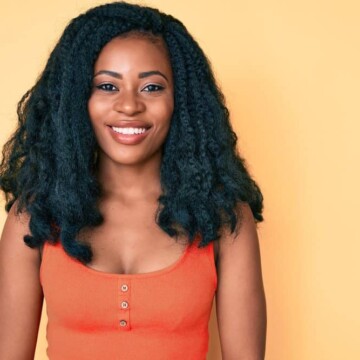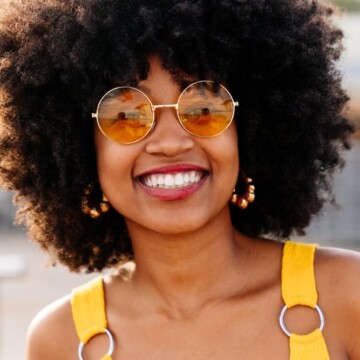
Unsatisfied with your hair dye job? If you’re thinking about redyeing it right away, pump your brakes! Read this article before you reach for the dye and try to correct your last coloring session.
We’re going to look at what happens when you dye your hair twice in one week and walk you through how to recolor it with minimal damage. Let’s get started!
Can I Dye My Hair Twice in One Week?
While it's not necessarily recommended, you can color your hair twice in one week. However, how often you should dye your hair depends on a few factors. Consider the following before you dye your hair twice, or more, during the same week:
- The health of your hair
- The type of dye you use
- The color you want to achieve
If you plan on dyeing your hair twice a week, use protein-rich hair products and plenty of moisturizing treatments in between coloring sessions.
These products will help combat the potential damage and keep your hair healthy enough to color again. Pay attention to the condition of your hair and avoid recoloring it if it is showing signs of extreme hair damage.
Key Takeaways
- Semi-Permanent vs. Permanent Dye: Semi-permanent hair color is gentler on hair than permanent dye, containing fewer harsh chemicals. It's safer if you're considering dyeing your hair a second time within a week, especially for maintaining your hair's health.
- Waiting Period Between Dye Jobs: Ideally, wait 6-8 weeks between permanent dye sessions to avoid hair breakage and maintain hair cuticle health. A shorter interval (2-4 weeks) is acceptable for semi-permanent or demi-permanent hair dye.
- Hair Damage Risks: Frequent dyeing, especially within a single day or the next day, can lead to hair breakage, damage to hair's cuticles, and uneven color. Consider hair type and condition before deciding on a new color or redoing a dye job.
- Hair Care Post-Dyeing: Use deep conditioning treatments and hair masks after dyeing to repair and protect hair strands. These help restore natural oils and maintain the integrity of the hair shaft, especially after using box dye or undergoing a chemical process like coloring.
- Professional Advice for Major Changes: For significant color changes (like going from dark to light hair or correcting a wrong color), consulting a hair salon professional is the best way to ensure the end result is achieved safely and effectively, minimizing harmful effects on hair.

Why You Shouldn’t Dye Your Hair Twice in One Week
Although you can technically color your hair twice in one week, professionals don’t usually recommend it. It can have various unintended consequences that ruin the look of your new hairdo.
Here are a few reasons you should avoid coloring your hair more often than once a week.
- Layering dye can cause unpredictable color results.
- Dyeing your hair too often can lead to significant damage and hair loss.
- Using incompatible hair dyes can create a severe chemical reaction.
- Overdyeing can make your color bleed, which could be a big mess.
Can You Bleach Your Hair Twice in a Week?
Under no circumstances should you bleach your hair twice in one week. Ideally, you should wait for approximately four to six weeks before attempting to lighten your hair again.
Bleach is highly abrasive and can cause your hair to suffer from extreme breakage or fall out. For a safer and more reliable color correction option, speak with your local hairstylist.
They will be able to lighten your hair while keeping damage to a minimum. But if you’d prefer to tackle it yourself, opt for gentle color adjusters like:
Is It Okay to Dye Hair Twice a Day?
Generally speaking, you should not dye your hair twice in one day. Even with mild hair dye types, dyeing your hair twice in one day can cause unpredictable results. Ideally, you should give your hair time to recover between dyeing sessions.

How Long to Wait Between Dye Sessions
Whether you want to correct your color or are ready to try a new shade, you’re probably wondering how much time needs to pass before you recolor your locks.
The exact length of time you should wait will depend on the type of dye you use, whether you plan on lightening or darkening your hair, and the health of your hair.
It’s a lot to keep track of, so here is a brief guide that explains how long you should wait between dyeing sessions.
Permanent Dye
Aside from bleach, permanent hair dye is one of the most damaging types of color processing. It requires the use of a developer, which contains harsh cuticle lifting ingredients like ammonia and peroxide (or alternatives that can be just as harmful).
To prevent severe chemical damage, try to stretch out your permanent dyeing sessions to once every 6 to 8 weeks. Wait longer if you plan on dyeing your hair a lighter color, as lightening your hair is riskier than darkening it.
Demi-Permanent Dye
Like permanent hair dyes, demi-permanent dyes are oxidative and require a developer to take. However, the developer strength used is much weaker than what you would use with permanent color. You can color your hair with demi-permanent dye every 2 to 4 weeks.
Semi-Permanent Dye
Semi-permanent hair dye doesn’t need a developer and is usually free from ingredients that leave your hair compromised. But even though it’s gentle, you should still wait for at least 48 hours before you attempt to color your hair again.
That gives your color a chance to settle in and fade a little bit, leaving you with a much better base for your next color application.
Another reason to wait before you recolor your hair is that applying too much semi-permanent color will cause your strands to become oversaturated.
Your hair’s innermost layers will essentially be too full to hold onto more pigment, and the dye will leak and drip until the excess is gone. The process is incredibly messy and can cause permanent staining on your clothes, towels, surfaces, and more.

Best Dye Type to Use for Frequent Dyeing
By far, the best type of dye to use for frequent dyeing is direct dye. Direct dyes are a family of temporary color solutions that don’t lighten your strands, don’t contain peroxide or ammonia, and fade away after a few washes.
Even though they don’t last as long as permanent hair color, direct dyes are a fun, easy, and safe way to experiment with color. They come in a variety of forms, including:
How to Repair Dye Damaged Hair
While waiting to dye your hair is the best option, sometimes life has other plans. If you have already experienced damage from coloring your hair too often, just follow these tips to nurse your damaged strands back to health.
- Trim your hair regularly - Although hair products can improve the hair’s appearance, cutting your hair is the only way to permanently eliminate split, damaged ends. Getting regular trims removes existing damage and stops new split ends before they have a chance to travel upwards and destroy even more of your hair.
- Deep condition your hair often - Deep conditioners and masks hydrate dry strands and repair and prevent damage. Pull out your deep conditioner once a week or two and give your hair some real TLC.
- Use protein-rich products - Damaged hair is typically highly porous. That means it has a lot of gaps and holes throughout its protective outer layer, the cuticle. Protein treatments repair the holes, which fortifies your strands and helps them hold onto moisture.
- Protect your strands - The more gently you treat your hair, the quicker it will recover from damage. There are many different ways you can show your hair some love. Here’s a quick crash course on how to best protect your hair.
- Wear protective styles like wigs, braids, or twists.
- Protect your hair from harsh UV rays.
- Limit heat styling to once a week or less.
- Cover your hair at night or sleep on a silk or satin pillowcase.
- Don’t brush or comb your hair while it’s wet unless it’s coated in a slippery detangling cream or conditioner.
- Recommend articles to learn more about protective styling:
- Nourish your hair from the inside out - Just like hair growth, healthy hair starts from the inside out. Make sure you’re drinking plenty of water and consider taking supplements if you have nutritional deficiencies.
Related Articles
- Can You Use Toner Without Developer
- How Long Should You Wait to Bleach Your Hair Again
- How Often Can I Tone My Hair
- How to Dilute 40-Volume Developer to 20
Even though you can color your hair twice in one week, waiting will give you a much better chance of achieving a satisfying color result. If you dye your hair frequently, opt for more gentle coloring solutions like semi-permanent and demi-permanent dyes.
We hope this article has helped shed some light on how often you should dye your hair and given you the tools to color your tresses without damaging them.




